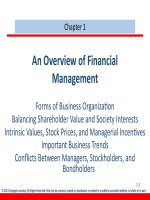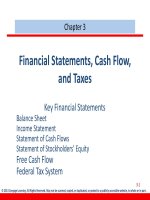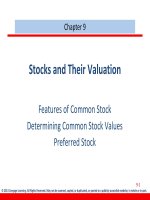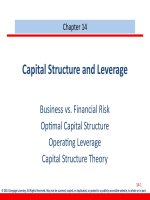tEST bANK fundamentals of financial management, 13th ed , pearson
Bạn đang xem bản rút gọn của tài liệu. Xem và tải ngay bản đầy đủ của tài liệu tại đây (271.54 KB, 78 trang )
TEST BANK
Fundamentals of Financial Management, 13th ed., Pearson
Chapter 1: The Role of Financial Management
Just click on the button next to each answer and you'll get immediate feedback.
Note: Your browser must support JavaScript in order to use this quiz.
1. "Shareholder wealth" in a firm is represented by:
the number of people employed in the firm.
the book value of the firm's assets less the book value of its liabilities.
the amount of salary paid to its employees.
the market price per share of the firm's common stock.
2. The long-run objective of financial management is to:
maximize earnings per share.
maximize the value of the firm's common stock.
maximize return on investment.
maximize market share.
3. What are the earnings per share (EPS) for a company that earned $100,000 last
year in after-tax profits, has 200,000 common shares outstanding and $1.2 million
in retained earning at the year end?
$100,000
$6.00
$0.50
$6.50
4. A(n)
would be an example of a principal, while a(n)
example of an agent.
would be an
shareholder; manager
manager; owner
accountant; bondholder
shareholder; bondholder
5. The market price of a share of common stock is determined by:
the board of directors of the firm.
the stock exchange on which the stock is listed.
the president of the company.
individuals buying and selling the stock.
6. The focal point of financial management in a firm is:
the number and types of products or services provided by the firm.
the minimization of the amount of taxes paid by the firm.
the creation of value for shareholders.
the dollars profits earned by the firm.
7. The decision function of financial management can be broken down into
the
decisions.
financing and investment
investment, financing, and asset management
financing and dividend
capital budgeting, cash management, and credit management
8. The controller's responsibilities are primarily
treasurer's responsibilities are primarily related to
in nature, while the
.
operational; financial management
financial management; accounting
accounting; financial management
financial management; operations
9. In the US, the
has been given the power to adopt auditing, quality
control, ethics, and disclosure standards for public companies and their auditors as
well as investigate and discipline those involved.
American Institute of Certified Public Accountants (AICPA)
Financial Accounting Standards Board (FASB)
Public Company Accounting Oversight Board (PCAOB)
Securities and Exchange Commission (SEC)
10. A company's
is (are) potentially the most effective instrument of good
corporate governance.
common stock shareholders
board of directors
top executive officers
11. The Sarbanes-Oxley Act of 2002 (SOX) was largely a response to:
a series of corporate scandals involving Enron, WorldCom, Global
Crossing, Tyco and numerous others.
a dramatic rise in the US trade deficit.
charges of excessive compensation to top corporate executives.
rising complaints by investors and security analysts over the financial
accounting for stock options.
The following item is NEW to the 13th edition.
12. ___________ refers to meeting the needs of the present without
compromising the ability of future generations to meet their own needs.
Corporate Social Responsibility (CSR)
Sustainability
Convergence
Green Economics
Chapter 2: The Business, Tax, and Financial Environments
Just click on the button next to each answer and you'll get immediate feedback.
Note: Your browser must support JavaScript in order to use this quiz.
1. Which of the following enjoys limited liability?
A general partnership.
A corporation.
A sole proprietorship.
None of the above.
2. Michael Cohn is a "member" (a type of owner) of a marine supply business.
Michael's business is
a sole proprietorship.
a corporation.
a limited liability company.
a general partnership.
3. The Counting House, Inc., purchased 5-year property class equipment for
$60,000. It uses the MACRS method of depreciation. What is tax depreciation for
the second year of the asset's life?
$12,000
$19,200
$20,000
$24,000
4. A corporation in which you are a shareholder has just gone bankrupt. Its
liabilities are far in excess of its assets. You will be called on to pay:
a proportionate share of bondholder claims based on the number of
common shares
that you own.
a proportional share of all creditor claims based on the number of
common shares
that you own.
an amount that could, at most, equal what you originally paid for the
shares of
common stock in the corporation.
nothing.
5. A 30-year bond issued by Gary's Plaid Pants Warehouse, Inc., in 1997 would
now trade in the
primary money market.
secondary money market.
primary capital market.
secondary capital market.
6. A major advantage of the corporate form of organization is:
reduction of double taxation.
limited owner liability.
legal restrictions.
ease of organization.
7. Money market mutual funds
enable individuals and small businesses to invest indirectly in moneymarket instruments.
are available only to high net-worth individuals.
are involved in acquiring and placing mortgages.
are also known as finance companies.
8. The purpose of financial markets is to:
increase the price of common stocks.
lower the yield on bonds.
allocate savings efficiently.
control inflation.
9. Which of the following is NOT an example of a financial intermediary?
International Business Machines, Inc. (IBM).
Vanguard Mutual Fund.
El Dorado Savings and Loan Association.
Bank of America.
10. How are funds allocated efficiently in a market economy?
The most powerful economic unit receives the funds.
The economic unit that is willing to pay the highest expected return
receives the funds.
the economic unit that considers itself most in need of funds
receives them.
Receipt of the funds is rotated so that each economic unit can receive
them in turn.
11. Assume that a "temporary" additional (US federal tax related) first-year
bonus depreciation of 50 percent applies to a new, $100,000 piece of equipment
purchased by Bellemans Chocolatier, Inc. The asset has a $10,000 estimated final
salvage value. If this asset is fully depreciated for tax purposes over its useful life,
the overall amount that Bellemans will have depreciated for tax purposes is
.
$90,000
$100,000
$135,000
$150,000
Chapter 3: The Time Value of Money
Just click on the button next to each answer and you'll get immediate feedback.
Note: Your browser must support JavaScript in order to use this quiz.
1. You want to buy an ordinary annuity that will pay you $4,000 a year for the
next 20 years. You expect annual interest rates will be 8 percent over that time
period. The maximum price you would be willing to pay for the annuity is closest
to
$32,000.
$39,272.
$40,000.
$80,000.
2. With continuous compounding at 10 percent for 30 years, the future value of
an initial investment of $2,000 is closest to
$34,898.
$40,171.
$164,500.
$328,282.
3. In 3 years you are to receive $5,000. If the interest rate were to suddenly
increase, the present value of that future amount to you would
fall.
rise.
remain unchanged.
cannot be determined without more information.
4. Assume that the interest rate is greater than zero. Which of the following cashinflow streams should you prefer?
Year1
Year2 Year3
$400
$300
$200
Year4
$100
$100
$200
$300
$400
$250
$250
$250
$250
Any of the above, since they each sum to $1,000.
5. You are considering investing in a zero-coupon bond that sells for $250. At
maturity in 16 years it will be redeemed for $1,000. What approximate annual rate
of growth does this represent?
8 percent.
9 percent.
12 percent.
25 percent.
6. To increase a given present value, the discount rate should be adjusted
upward.
downward.
True.
Fred.
7. For $1,000 you can purchase a 5-year ordinary annuity that will pay you a
yearly payment of $263.80 for 5 years. The compound annual interest rate implied
by this arrangement is closest to
8 percent.
9 percent.
10 percent.
11 percent.
8. You are considering borrowing $10,000 for 3 years at an annual interest rate of
6%. The loan agreement calls for 3 equal payments, to be paid at the end of each of
the next 3 years. (Payments include both principal and interest.) The annual
payment that will fully pay off (amortize) the loan is closest to
$2,674.
$2,890.
$3,741.
$4,020.
9. When n = 1, this interest factor equals one for any positive rate of interest.
PVIF
FVIF
PVIFA
FVIFA
None of the above (you can't fool me!)
10. (1 + i)
n
PVIF
FVIF
PVIFA
FVIFA
11. You can use
to roughly estimate how many years a given sum of
money must earn at a given compound annual interest rate in order to double that
initial amount .
Rule 415
the Rule of 72
the Rule of 78
Rule 144
12. In a typical loan amortization schedule, the dollar amount of interest paid
each period
.
increases with each payment
decreases with each payment
remains constant with each payment
13. In a typical loan amortization schedule, the total dollar amount of money
paid each period
.
increases with each payment
decreases with each payment
remains constant with each payment
Chapter 4: The Valuation of Long-Term Securities
Just click on the button next to each answer and you'll get immediate feedback.
Note: Your browser must support JavaScript in order to use this quiz.
1. What's the value to you of a $1,000 face-value bond with an 8% coupon rate
when your required rate of return is 15 percent?
More than its face value.
Less than its face value.
$1,000.
True.
2. If the intrinsic value of a stock is greater than its market value, which of the
following is a reasonable conclusion?
The stock has a low level of risk.
The stock offers a high dividend payout ratio.
The market is undervaluing the stock.
The market is overvaluing the stock.
3. When the market's required rate of return for a particular bond is much less
than its coupon rate, the bond is selling at:
a premium.
a discount.
cannot be determined without more information.
face value.
4. If an investor may have to sell a bond prior to maturity and interest rates have
risen since the bond was purchased, the investor is exposed to
the coupon effect.
interest rate risk.
a perpetuity.
an indefinite maturity.
5. Virgo Airlines will pay a $4 dividend next year on its common stock, which is
currently selling at $100 per share. What is the market's required return on this
investment if the dividend is expected to grow at 5% forever?
4 percent.
5 percent.
7 percent.
9 percent.
6. If a bond sells at a high premium, then which of the following relationships
hold true? (P0 represents the price of a bond and YTM is the bond's yield to
maturity.)
P0 < par and YTM > the coupon rate.
P0 > par and YTM > the coupon rate.
P0 > par and YTM < the coupon rate.
P0 < par and YTM < the coupon rate.
7. Interest rates and bond prices
move in the same direction.
move in opposite directions.
sometimes move in the same direction, sometimes in opposite directions.
have no relationship with each other (i.e., they are independent).
8. In the formula k = (D /P ) + g, what does g represent?
e
1
0
the expected price appreciation yield from a common stock.
the expected dividend yield from a common stock.
the dividend yield from a preferred stock.
the interest payment from a bond.
9. In the United States, most bonds pay interest
European bonds pay interest
a year, while many
a year.
once; twice
twice; once
once; once
twice; twice
10. The expected rate of return on a bond if bought at its current market price
and held to maturity.
yield to maturity
current yield
coupon yield
capital gains yield
Chapter 5: Risk and Return
Just click on the button next to each answer and you'll get immediate feedback.
Note: Your browser must support JavaScript in order to use this quiz.
1. This type of risk is avoidable through proper diversification.
portfolio risk
systematic risk
unsystematic risk
total risk
2. A statistical measure of the degree to which two variables (e.g., securities'
returns) move together.
coefficient of variation
variance
covariance
certainty equivalent
3. An "aggressive" common stock would have a "beta"
equal to zero.
greater than one.
equal to one.
less than one.
4. A line that describes the relationship between an individual security's returns
and returns on the market portfolio.
characteristic line
security market line
capital market line
beta
5. According to the capital-asset pricing model (CAPM), a security's expected
(required) return is equal to the risk-free rate plus a premium
equal to the security's beta.
based on the unsystematic risk of the security.
based on the total risk of the security.
based on the systematic risk of the security.
6. The risk-free security has a beta equal to
portfolio's beta is equal to
, while the market
.
one; more than one.
one; less than one.
zero; one.
less than zero; more than zero.
7. Carrie has a "certainty equivalent" to a risky gamble's expected value that is
less than the gamble's expected value. Carrie shows
risk aversion.
risk preference.
risk indifference.
a strange outlook on life.
8. Beta is the slope of
the security market line.
the capital market line.
a characteristic line.
the CAPM.
9. A measure of "risk per unit of expected return."
standard deviation
coefficient of variation
correlation coefficient
beta
10. The greater the beta, the
of the security involved.
greater the unavoidable risk
greater the avoidable risk
less the unavoidable risk
less the avoidable risk
11. Plaid Pants, Inc. common stock has a beta of 0.90, while Acme Dynamite
Company common stock has a beta of 1.80. The expected return on the market is
10 percent, and the risk-free rate is 6 percent. According to the capital-asset pricing
model (CAPM) and making use of the information above, the required return on
Plaid Pants' common stock should be
, and the required return on Acme's
common stock should be
.
3.6 percent; 7.2 percent
9.6 percent; 13.2 percent
9.0 percent; 18.0 percent
14.0 percent; 23.0 percent
12. Espinosa Coffee & Trading, Inc.'s common stock measured beta is
calculated to be 0.75. The market beta is, of course, 1.00 and the beta of the
industry of which the company is a part is 1.10. If Merrill Lych were to calculate
an "adjusted beta" for Espinosa's common stock, that adjusted beta would most
likely be
.
less than 0.75
more than 0.75, but less than 1.10
equal to 1.10
equal to 0.95 {i.e., (1/3) x (0.75 + 1.00 + 1.10)}
Chapter 6: Financial Statement Analysis
Just click on the button next to each answer and you'll get immediate feedback.
Note: Your browser must support JavaScript in order to use this quiz.
1. Determine a firm's total asset turnover (TAT) if its net profit margin (NPM) is
5 percent, total assets are $8 million, and ROI is 8 percent.
1.60
2.05
2.50
4.00
2. Felton Farm Supplies, Inc., has an 8 percent return on total assets of $300,000
and a net profit margin of 5 percent. What are its sales?
$3,750,000
$480,000
$300,000
$1,500,000
3. Which of the following would NOT improve the current ratio?
Borrow short term to finance additional fixed assets.
Issue long-term debt to buy inventory.
Sell common stock to reduce current liabilities.
Sell fixed assets to reduce accounts payable.
4. The gross profit margin is unchanged, but the net profit margin declined over
the same period. This could have happened if
cost of goods sold increased relative to sales.
sales increased relative to expenses.
the U.S. Congress increased the tax rate.
dividends were decreased.
5. Palo Alto Industries has a debt-to-equity ratio of 1.6 compared with the
industry average of 1.4. This means that the company
will not experience any difficulty with its creditors.
has less liquidity than other firms in the industry.
will be viewed as having high creditworthiness.
has greater than average financial risk when compared to other firms in
its industry.
6. Kanji Company had sales last year of $265 million, including cash sales of $25
million. If its average collection period was 36 days, its ending accounts receivable
balance is closest to
. (Assume a 365-day year.)
$26.1 million
$23.7 million
$7.4 million
$18.7 million
7. A company can improve (lower) its debt-to-total assets ratio by doing which of
the following?
Borrow more.
Shift short-term to long-term debt.
Shift long-term to short-term debt.
Sell common stock.
8. Which of the following statements (in general) is correct?
A low receivables turnover is desirable.
The lower the total debt-to-equity ratio, the lower the financial risk for a
firm.
An increase in net profit margin with no change in sales or assets means
a poor ROI.
The higher the tax rate for a firm, the lower the interest coverage ratio.
9. Retained earnings for the "base year" equals 100.0 percent. You must be
looking at
a common-size balance sheet.
a common-size income statement.
an indexed balance sheet.
an indexed income statement.
10. Krisle and Kringle's debt-to-total assets (D/TA) ratio is .4. What is its debtto-equity (D/E) ratio?
.2
.6
.667
.333
11. A firm's operating cycle is equal to its inventory turnover in days (ITD)
plus its receivable turnover in days (RTD).
minus its RTD.
plus its RTD minus its payable turnover in days (PTD).
minus its RTD minus its PTD.
12. When doing an "index analysis," we should expect that changes in a number
of the firm's current asset and liabilities accounts (e.g., cash, accounts receivable,
and accounts payable) would move roughly together with
for a normal, wellrun company.
net sales
cost of goods sold
earnings before interest and taxes (EBIT)
earnings before taxes (EBT)
The following item is NEW to the 13th edition.
13. The process of convergence of accounting standards around the world aims
to
.
narrow or remove national accounting differences
move non-US accounting standards towards US Generally Accepted
Accounting Principles (US GAAP)
create one set of rules-based accounting standards for all countries
Clear Answ ers
Chapter 7: Funds Analysis, Cash Flow Analysis, and Financial Planning
Just click on the button next to each answer and you'll get immediate feedback.
Note: Your browser must support JavaScript in order to use this quiz.
1. According to the accounting profession, which of the following would be
considered a cash-flow item from an "investing" activity?
cash inflow from interest income.
cash inflow from dividend income.
cash outflow to acquire fixed assets.
all of the above.
2. According to the Financial Accounting Standards Board (FASB), which of the
following is a cash flow from a "financing" activity?
cash outflow to the government for taxes.
cash outflow to shareholders as dividends.
cash outflow to lenders as interest.
cash outflow to purchase bonds issued by another company.
3. If the following are balance sheet changes:
$5,005 decrease in accounts receivable
$7,000 decrease in cash
$12,012 decrease in notes payable
$10,001 increase in accounts payable
a "use" of funds would be the:
$7,000 decrease in cash.
$5,005 decrease in accounts receivable.
$10,001 increase in accounts payable.
$12,012 decrease in notes payable.
4. On an accounting statement of cash flows an "increase(decrease) in cash and
cash equivalents" appears as
a cash flow from operating activities.
a cash flow from investing activities.
a cash flow from financing activities.
none of the above.
5. Uses of funds include a (an):
decrease in cash.
increase in any liability.
increase in fixed assets.
tax refund.
6. Which of the following would be included in a cash budget?
depreciation charges.
dividends.
goodwill.
patent amortization.
7. An examination of the sources and uses of funds statement is part of:
a forecasting technique.
a funds flow analysis.
a ratio analysis.
calculations for preparing the balance sheet.
8. Which of the following is NOT a cash outflow for the firm?
depreciation.
dividends.
interest payments.
taxes.
9. Which of the following would be considered a use of funds?
a decrease in accounts receivable.
a decrease in cash.
an increase in account payable.
an increase in cash.
10. The cash flow statement in the United States is most likely to appear using
a "supplementary method."
a "direct method."
an "indirect method."
a "flow of funds method."
11. For a profitable firm, total sources of funds will always
total uses of
funds.
be equal to
be greater than
be less than
have no consistent relationship to
Chapter 8: Overview of Working Capital Management
Just click on the button next to each answer and you'll get immediate feedback.
Note: Your browser must support JavaScript in order to use this quiz.
1. In finance, "working capital" means the same thing as
total assets.
fixed assets.
current assets.
current assets minus current liabilities.
2. Which of the following would be consistent with a more aggressive approach
to financing working capital?
Financing short-term needs with short-term funds.
Financing permanent inventory buildup with long-term debt.
Financing seasonal needs with short-term funds.
Financing some long-term needs with short-term funds.









